Tiny Packs –
The Law of Luggage states: “The amount of stuff you carry will expand to fit whatever size backpack you have.” For this reason and a few others, I use a tiny little 15 liter pack for backcountry skiing in the Wasatch.
Between racing packs and mechanized skiing packs, there are quite a few small packs on the market today. The mechanized skiing packs are meant for chairlifts, heliskiing or cat skiing, but for fruffy places like the Wasatch where it doesn’t get that cold and you are never far from the road or help, they make great backcountry packs as well. I’ve been using a Mountain Hardwear Chuter 15 pack for the last few years, which was only on the market for about ten days, but there are plenty of other good ones out there.
Advantages:
- It is much easier to ski with less weight and bulk on your back.
- With a really small, light pack, most of the time you can get by with just the sternum buckle and hardly need the waistbelt buckle
- Less weight means more vertical
- A light pack means more fun and less pain.
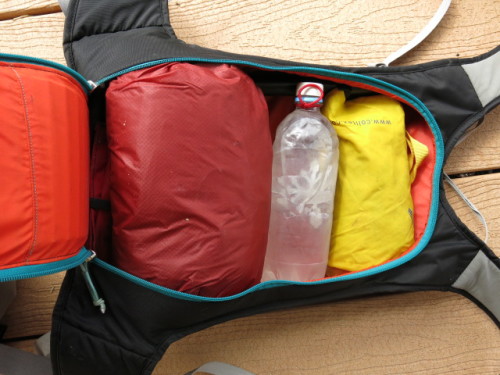
The external pockets hold avalanche gear (shovel, handle, probe) and the interior is just big enough for a puffy jacket, a liter of water, a bit of food and a tiny First Aid kit. Extra gloves, thermos and ski ‘poons need not apply.
One key design feature to look for in a micro pack is the ability to strap things onto the back of it. I prefer a centered hypalon daisy chain with slots wide enough for a Voile strap. This way you are assured of always having a Voile strap with you, plus you can attach bulky items like skins or jackets.
As far as not being able to carry much, it is something you get used to. As ultralight hiking guru Ray Jardine says, “If you need something and you don’t have it, then you don’t need it.” In other words, you will have to make do.
________________________________
Help support StraightChuter.com and check out the micro POC Thorax 11 JetForce Backpack from Backcountry.com. Click on the photo below.
Category: 02 Gear, Gear Reviews

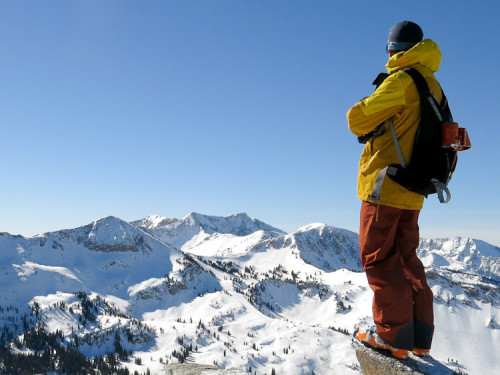
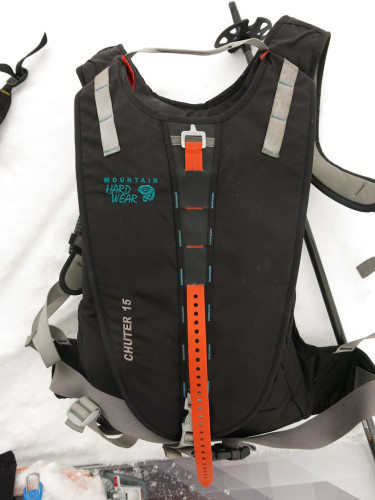
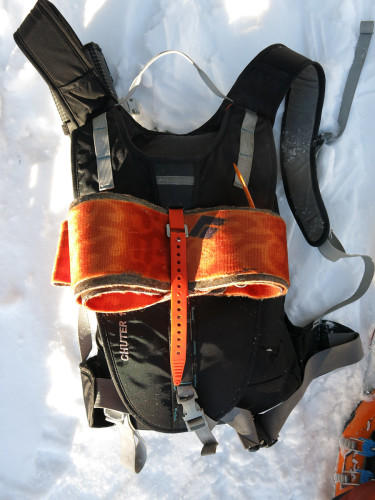
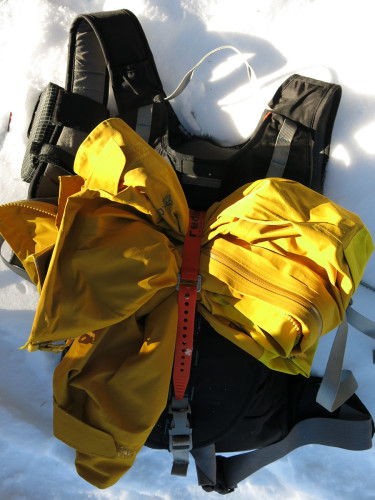









Nice one Andrew! So the Chuter 15 pack will be making a comeback? Parallel to Jardine, Wayne Gretzky said “I miss all the shots I don’t make”, somehow I don’t miss all the stuff I don’t take.
Awesome post; addressed some of the questions I’d had about your use (and design) of the Chuter 15. Would your gear selection change much when day touring in less-populated parts of the country?
I’d strongly considered the Chuter 15 as a new light-duty pack (I’ve been on multi-day mountaineering trips with a Flash 18), but I couldn’t reconcile the capacity against the gear I think I need to remain safe (non-hypothermic) in the wintertime WA Cascades. A messed-up leg in deep wet snow can force you to stay in place for a long time if a partner has to go for help.
Would love to hear your thoughts, as there’s a lot to like about the philosophy implied by the Chuter and similar packs.. Thanks!
As a followup, a few quick thoughts on how you manage water and food would be interesting, too. Do you tank up at home/again at the car?
Thanks!
I can’t stand tiny packs, but hate heavy packs also. Small packs really make no sense (to me) when we know about things like inverse segregation. And packing them with what you need for a day in western Canada is painful (time consuming and frustrating). I go with a 50 litre pack that I pack very lightly and don’t compress. It skis fine with high volume low mass, unless you are flailing all over the mountain (or taking a chairlift). I can take the gear I need (often ski and boot crampons with harness, rope, axe and crevasse gear) and it’s all easily accessible. 50 litres may not be much for inverse segregation but it’s better than 15 with no real weight cost. My 2 cents.
Any recommendations for other good packs for day trips in the backcountry plus some lift served skiing? I’ve been looking at the Black Diamond Agent (18L in a small w/ avalung) but would love to hear thoughts on other packs as well.
Darren, You really think a 50l pack would have any influence on inverse segregation in the event os an avalanche?
In that case a pack will just be compressed, taking off all the air and space so The volumen advantage in inverse segregation will be lost.
Pablo,
Again I will say 50 is bigger than 15. I use hard plastic water bottles and lunch boxes as well as a thermos to fill a lot of my pack even when they are empty. If these things were crushed in an avalanche then I’m pretty I would be too. I also don’t like to try and cram necessary things into a tiny pack. To each their own.
Any thoughts on the Osprey Reverb 18 or Kode 22?
My wife subscribes to this theory of packing. It’s easy for her, whatever she can’t fit (thermos, food, extra layers, extra mitts, ‘poons) she just gives to me saying, “well, you can fit it in your 35 liter pack, mine’s not big enough.”
Flawless logic.